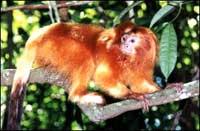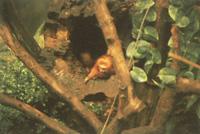Hopeful solution for Tamarin León
2001/04/04 Galarraga Aiestaran, Ana - Elhuyar Zientzia

In the Atlantic precipitation of Brazil, its last refuge, 1,000 tamarins live and so that the species can survive, at least, 2,000. However, it is the largest amount that has been recorded in the last 30 years, since by 1970 less than 200 wild tamarines lived in the jungle, that is, the species was about to disappear.
The reduction of the number of animals is mainly due to the progressive disappearance of their residence. In fact, they now live in the rain forest of the state of Rio de Janeiro, but once that forest was much larger and had the same surface as Egypt. Today, on the contrary, only 7% of the forest remains and remains below 2% of the natural habitat of the tamarines, without any change.
The first project that the World Wildlife Foundation (WWF) carried out in Brazil was to save the golden lion tamarines and now brings together 39 organizations and 140 zoos. Since 1984, 147 tamarins born in zoos have been released in the wild, most of them well adapted and with young. Thus, 320 animals have been added to the wild population during that time. In addition, 12 groups of animals have moved from small, isolated areas to wider areas, where they are more likely to obtain food.
On the other hand, the placement of radio collars was tested for animal monitoring, but the researchers saw that they collected signs of dead animals. For example, several times the radius was found in the stomach of some snake, as it stayed there after eating a tamarin.
A WWF member believes that more and more predators get to catch the whole team. It seems that a mustard similar to the erbinudio has learned to remove it from the dens where the tamarines sleep and has become one of the greatest enemies of the tamarines.
The next objective of WWF is to create 13 corridors that connect 14 small areas of Tamarines. This greatly expands the habitat of the tamarins in these areas. In addition, the benefit would not be exclusive to tamarines.
In the Atlantic jungle live more than 2,000 types of butterflies and in a single hectare there 450 species of trees. There are 680 species of birds, of which 199 live nowhere else. Other threatened mammals also inhabit this jungle, such as a type of spider monkey and a kind of sloth.

Gai honi buruzko eduki gehiago
Elhuyarrek garatutako teknologia






